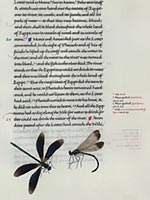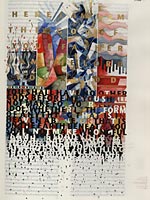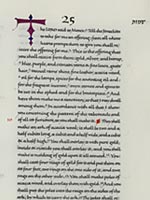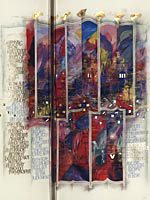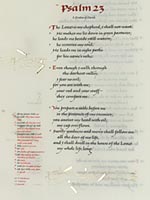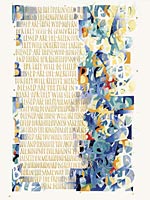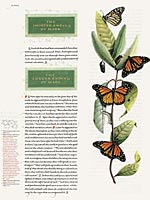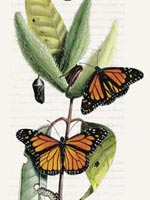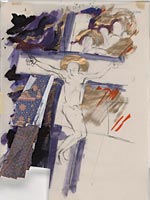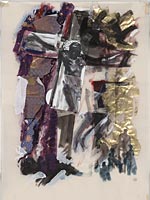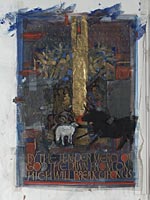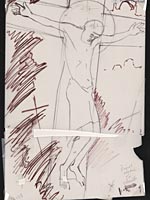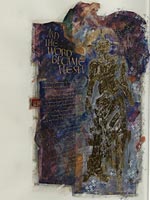Online Exhibition
The St. John's Bible
This exhibition is devoted to a single work of art, an illuminated, handwritten Bible commissioned by Saint John's University and Abbey in Minnesota. This contemporary Bible is at once old and new: a masterpiece of the ancient crafts of calligraphy and illumination that could only be made by artists of today. The Saint John's Bible is being created by professional scribes in a scriptorium in Wales, under the direction of Donald Jackson, one of the world's foremost calligraphers. Begun at the start of the new millennium, this unique undertaking combines a centuries-old tradition of craftsmanship with the latest capabilities of computer technology and electronic communication. It is a collaborative effort, involving many persons in both Wales and the United States. In the Middle Ages, monumental Bibles were made for daily use in monastic communities, yet they were carefully preserved for future generations. The Saint John's Bible is the modern representative of that great tradition. The pages of the Bibles shown in this exhibition represent a work in progress. The completion date for the St. John's Bible is 2008.
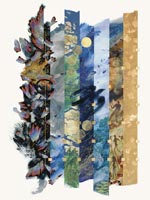
Donald Jackson with
contributions from Chris Tomlin
Genesis Frontispiece: Creation
(Genesis 1:1-2:3) (1)
[Digital ID# itw0001]
Creation
The structure of this illumination reflects the seven-day progression of the Bible's Creation story, with seven vertical strips, one for each day. On the first day, fragmented shapes explode from the primordial void, expressed by the Hebrew words "tohu wabohu" (chaos). A vertical gold line marks the moment in the story when God ordered, "Let there be light." Day three contains satellite pictures of the Nile Delta, suggesting the division of land and water and the beginnings of vegetation. The creation of human beings on the sixth day is represented by images from aboriginal rock paintings in Africa and Australia. The snake implies dangers to come, in the Garden of Eden. The golden seventh day is given over entirely to the contemplation of the spirit. The raven flying across the composition is the traditional carrier of God's message to Saint Benedict.
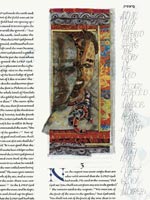
Donald Jackson with
contributions from Chris Tomlin
Adam and Eve
(Genesis 2:4-25) (2.1)
[Digital ID# itw0002_1]
Adam and Eve
Adam and Eve are presented as an African man and woman surrounded by patterned fabrics from various ancient cultures. Photographs of Ethiopian tribes-people influenced Jackson's design. He wanted to link the notion of the Bible's first man and woman with current archaeological and anthropological theories that humankind originated in Africa. The decorative framing around Adam and Eve includes African tapestry patterns and, on the right, a Peruvian feather cape. The horizontal stripes are details of Middle Eastern textiles and of white body painting on black skin. The poisonous coral snake, also depicted in the Creation and Garden of Eden illuminations, appears between Adam and Eve. Jackson's use of a gold bar framing Adam and Eve is meant to suggest God's presence as a framework for human life.
Tiger Swallowtail Butterflies

Chris Tomlin, artist
Tiger Swallowtail Butterflies
Marginalia, Genesis 3-6 (2.2)
[Digital ID# itw002_2]
Jacob's Ladder
This image evokes the surreal wonder of Jacob's dream about angels ascending and descending a ladder that reached from earth to heaven. According to the Bible, in that moment when heaven and earth were briefly joined, Jacob realized his special relationship with God. Accompanying the abstract gold angels are fragments of realistic butterfly wings. They echo the angels' wings, becoming an earthly analogy for angels and also a metaphor for the fleeting nature of Jacob's vision. The butterflies appear against a lacy pattern of gold, a gossamer presence. The quotation along the bottom, which can be linked with words from the preceding verse--"Surely God is in this place"--refers to Jacob's powerful and moving experience.
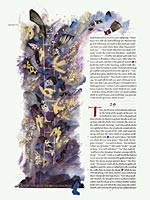
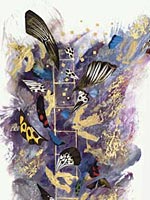
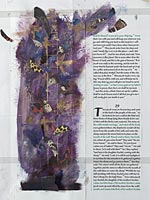
Donald
Jackson in
collaboration with Chris Tomlin
Jacob's
Ladder
(Genesis 28:10-17) (3)
[Digital ID# itw0003]
Detail
[Digital ID# itw0003a]
Preparatory Sketch
[Digital ID# itw0022]
Damselflies
The Ten Commandments
The theological brief from the Committee on Illumination and Text required the artist to combine five different passages from Exodus into a single illumination. Since the committee's brief also suggested that the giving of the Ten Commandments represented a new creation, they were chosen to create the principal image around which to group the others. Depicted along the top of the composition are the burning bush, the first Passover, the crossing of the Red Sea, and the twelve pillars, representing the twelve tribes of Israel, erected at the foot of Mount Sinai. The lower half of the page contains the Ten Commandments, overlapping and dissolving the colored background. Instead of writing the words, the artist stenciled them, using the typeface Stone Sans to emphasize the authoritarian nature of God's words.
Capital Letters
Special Treatment, Deuteronomy
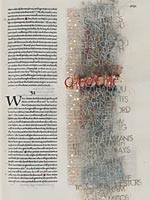
Suzanne
Moore, artist
"Choose
Life"
Special
treatment,
Deuteronomy 30:19-20 (7)
[Digital ID# itw0007]
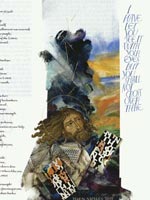
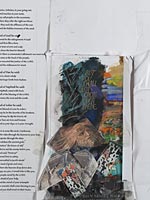
Donald Jackson in collaboration with Aidan Hart
and contributions from Sally Mae Joseph
The Death of Moses (Deuteronomy 34:1-12) (8)
[Digital ID# itw0008]
Preparatory Sketch [Digital ID# itw000023]
The Death of Moses
Moses is shown with fragments of the tablets of the Ten Commandments and a prayer shawl patterned after a traditional Middle Eastern design. Mount Nebo is depicted in the background. According to the Bible, God led Moses to the top of Mount Nebo, from where he could see the Promised Land. However, Moses was not allowed to enter the Promised Land because of a momentary lack of trust in God. He died on the mountain.
Special Treatment, Numbers
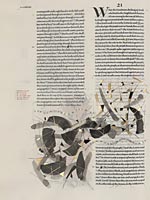
Thomas Ingmire, artist
"Make
a poisonous serpent"
Special treatment,
Numbers 21:8 (9)
[Digital ID# itw0009]
Psalms Frontispiece
In the Bible, the book of Psalms is divided into five books, and this frontispiece visually reflects that structure. The five books are represented by five overlapping book-shaped panels, each a different combination of the same colors. A gold roman numeral identifies each panel. These panels reappear at the beginning of each book in a progressive accumulation corresponding to the numbers of the books. Only in the Psalms do all the illuminations in the Saint John's Bible consist of abstract, nonillustrative designs. Superimposed on this image are digital voiceprints (electronic images of sound) of the monks at Saint John's Abbey singing Gregorian chant; a Native American sacred song; a Jewish men's chorus singing psalms; Buddhist tantric harmonics; an Islamic call to prayer (adhan); Taoist temple music; Hindu bhajan; and Indian Sufi chant. The voiceprints of the Saint John's monks appear on every page, moving horizontally throughout the Psalms in gold.
Psalms
Special Treatment, Psalms
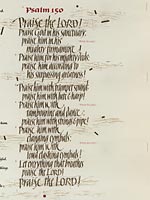
Sally Mae Joseph, artist and scribe
"Praise
the Lord"
Special treatment, Psalm 150
Psalms 146-150 (12)
[Digital ID# itw0012]
Matthew Frontispiece: The Genealogy of Christ
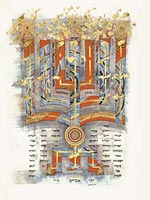
Donald Jackson, artist and scribe
Matthew Frontispiece:
The Genealogy of Christ
(Matthew 1:1-17) (13)
[Digital ID# itw0013]
The Gospel of Matthew begins with the genealogy of Christ. Reaching back into the Old Testament scriptures to Abraham, progenitor of the Hebrew nation, Matthew lists the names of succeeding generations, culminating in the birth of Christ. This illumination is a family tree structured as both a tree of life and a menorah, the Jewish seven-branched candelabra. Placed at the beginning of the first gospel, the menorah serves as a bridge between the Old and New Testaments. A mandala-like cosmic image near the base is common to several religions and implies the universality of the search for a supreme being. The intricate gold medallions above the menorah were inspired by illuminations from the Koran. Reflecting our own time, patterns of DNA double helixes between the outer branches emphasize the connectedness of all humanity. The ancestral names flank the base of the menorah/tree and climb between the innermost branches. Abraham's name appears in English and Hebrew, with that of his wife, Sarah, from whom these generations arose. Named in both Arabic and English is Hagar, Sarah's handmaiden, with whom Abraham fathered Ishmael, the ancestor of the prophet Muhammad, founder of Islam. At the very top is the name of Jesus, in the same lettering style as Abraham, David, Mary, and Joseph.
Beatitudes
The letters of the word "blessed" are scattered randomly in a multicolored pattern, here and there reuniting to form the word. The overall effect recalls mosaic decoration, a traditional artistic medium dating to pre-classical times in the Near East.
Monarch Butterflies
The margins of medieval Bibles were often decorated with plants and animals that had symbolic meanings. In Christian art the butterfly symbolizes resurrection. The three stages of its life--caterpillar, chrysalis, and butterfly-- correspond to life, death, and resurrection. In The Saint John's Bible, all the species of flora and fauna depicted in the margins are native to the Minnesota woods surrounding Saint John's University or to the Welsh countryside near Donald Jackson's home. Chris Tomlin, a specialist in botanical and nature illustration, came to Minnesota to research subjects for marginalia, and these monarch butterflies help root this Bible in the community of Saint John's Abbey and University in Minnesota. The blank vellum page stands in for the first page of the Book of Luke.
The Parable of the Sower and the Seed
(Mark 4:3-9)
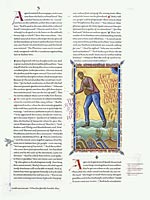
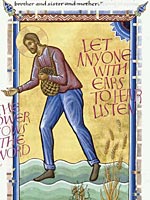
Aidan Hart with contributions from Donald Jackson
and Sally Mae Joseph
The Parable of the Sower and the Seed (Mark 4:3-9) (16)
[Digital ID# itw0016]
Detail (16a)
[Digital ID# itw0016a]
In this icon-like image, the sower's halo, with its cross, identifies the figure as Christ sowing the word of God. His contemporary Western work clothes indicate that this image is a metaphor, in which the sacred message is revealed through a mundane action. The four small hills along the bottom signify the four kinds of soil on which the sower's seed falls. According to the Bible parable, the hard path, where the seed cannot take root and is eaten by birds, signifies the closed mind that refuses to hear God's word. The rocky ground, where the sprout is short-lived, represents shallow people who accept the word of God but do not let it take root in their inner being and fall away when they are persecuted. The thorny ground corresponds to people who understand God's word but let material things choke their spiritual belief. The good soil, where the wheat has taken root and thrives, represents those who act upon the word of God and share it with others. One of the birds has "escaped" from the illumination to pick up a missing line. Its beak points to where the line belongs.
The Multiplication of the Loaves and Fishes
(Mark 6:30-44, 8:1-10)
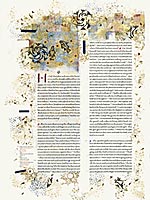
Donald Jackson
The Multiplication of the
Loaves and Fishes
(Mark 6:30-44, 8:1-10) (17)
[Digital ID# itw0017]
In the Gospel of Mark he narrates twice the story of Christ providing food for multitudes of people, probably giving two versions of the same event. This illumination accompanies the first version, in which Christ miraculously multiplied five loaves and two fishes to feed five thousand people, with twelve baskets of leftovers. Tradition locates this event at Tabgha, on the west side of the Sea of Galilee. In this image, the stamped images of fish derive from a mosaic in Tabgha and the circular loaves, marked with a cross, prefigure the bread of the Eucharist (Communion). The baskets (shown partially) have geometric designs based on ancient Native American Anasazi basketry, acknowledging the American origin of this Bible and the coexistence of other beliefs.
The Luke Anthology
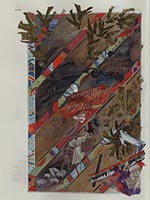
Donald Jackson with contributions
from Sally Mae Joseph
and Aidan Hart
The Luke Anthology (18)
[Digital ID# itw0018]
In this image five parables and one story unique to the Gospel of Luke are illustrated in diagonal bands that read in descending order from left to right. The three "parables of the lost" are about God seeking and finding lost sinners. The image of Christ at the top right figures in all the scenes.
Parable of the Lost Coin (15:8-10): Scattered coins represent the boundless joy of a woman who has turned her house upside down to find her lost coin. Parable of the Lost Sheep (15:4-7): A bedraggled sheep, alone in the dark, looks toward the golden light streaming from Christ and his angels, which promises rescue and return to the fold.
Parable of the Good Samaritan (10:29-37): Quotations from the text spell out the triumph of love over sectarianism and over adherence to doctrine at the expense of compassion.
Parable of the Lost Son (15:11-32): The erring son leaves the pigs he has tended and returns to his father, who runs to meet him and forgive him. The twin towers of the World Trade Center point to the need for forgiveness in our time and for seeking alternatives to revenge.
Parable of Dives and Lazarus (16:19-31): Dives ("wealthy one") feasted while Lazarus begged at his door. The scene shows them after death, separated by a chasm: Lazarus, carried by angels, rests with Abraham, while Dives suffers the fiery torments of hell.
Martha and Mary (10:38-42): The sisters look toward Jesus, who approved Mary's listening to his teaching and rebuked Martha's unneeded acts of hospitality.
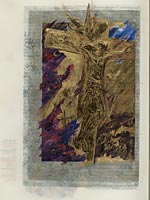
Donald
Jackson
The
Crucifixion
(Luke 23:44-49) (19)
[Digital ID# itw0019]
The Crucifixion
(Luke 23:44-49)
Rendered in raised and burnished gold, the crucified figure of Christ dominates this composition. Luke's Gospel recounts that upon Christ's death darkness covered the earth for three hours, indicated here by the night sky, and that the curtain of the temple, shown as shreds of purple, was torn in two. The contrast of pain with the glory of gold relates this image to current theological discussions concerning the meaning of the Crucifixion in the contemporary world. The delicate gray border was printed with English lace, contributing to the recurring theme of textiles in The Saint John's Bible illuminations.
John Frontispiece: The Word Made Flesh
(John 1:1-14)
Stepping out of darkness, which alludes to the chaos that precedes Creation in the Bible, the golden figure of Christ brings light and order. Words in golden script, from Colossians 1:15-20, link the figure of Christ with the words "And lived among us" at the upper right. A keyhole jutting into the left margin recalls the tradition of locked and hinged manuscripts in securing, protecting, and holding the "key" to the Word of God.
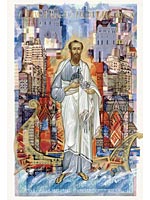
Donald Jackson in collaboration
with Aidan Hart and with
contributions from Andrew Jamieson
The Life of Paul (Acts) (21)
[Digital ID# itw0021]
The Life of Paul
(Acts)
Paul was the apostle to the Gentiles, and he traveled as a missionary throughout the Near East. He is posed here in the manner of classical Greek statues. A prayer shawl draped over his shoulders indicates his upbringing as a devout Jew. Surrounding him are secular and sacred buildings from nearly every historical period of the last two thousand years. Because he made several sea voyages and was once shipwrecked, Paul stands before a Greco-Roman sailing vessel. An energetic church builder, he holds a model of a church that recalls Saint Peter's Basilica in Rome, the city where he was martyred under the emperor Nero. The words at the top, "I saw a light from heaven" (26:13), refer to Paul's conversion to Christianity. Those across the bottom proclaim his divine mission: "The Lord has commanded us, saying, ‘I have set you to be a light for the Gentiles, so that you may bring salvation to the ends of the earth'" (13:47).
Luke frontispiece: The Birth of Christ
(Luke 2:1-20)
Gold is used throughout The Saint John's Bible to indicate the divine. Here a brilliant shaft of light, executed in gold leaf, rises from the child's crib, making the Christ Child the focal point of this scene, although he is not pictured. His mother, Mary, gazes tenderly on the infant. The shepherds are women and girls, which was probably the case at the time of Christ. Between the viewer and the unseen infant, the animals form a protective barrier. The ox is modeled on one of the Neolithic cave paintings of great aurochs at Lascaux, France. The upper text is the angels' song. The central text refers to this child's role as "light to those who sit in darkness," and the lower text anchors the entire illumination in a metaphor of divine light.
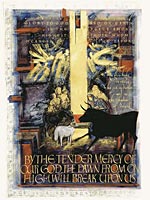
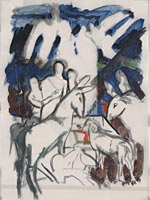
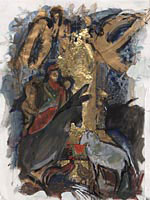
Donald
Jackson
Luke
Frontispiece:
The Birth of Christ
(Luke
2:1-20) (34)
[Digital ID# itw0034]
Preparatory Sketches
[Digital ID# itw0032, itw0033]
Bibles at the Library of Congress
In addition to the St. John's Bible, this installation includes a selection of rare materials from the Library of Congress collections. On exhibition are several priceless volumes from the Library's extraordinary collection of 1500 printed Bibles housed in the Rare Book and Special Collections Division. Chosen to illustrate a wide range of formats and printing and artistic achievements, the works on display cover more than five centuries and include an early classic Bible printed in Venice in 1479, a Bible translated into Algonquin, the Bible used by the Pilgrims and Puritans, and an 18th century children's Bible. This glimpse into the Library's rich collections also includes a multi-media presentation that provides a brief overview of illuminated works in the Library's medieval and renaissance manuscript collections. Focusing on works from the 13th through the 16th centuries, this presentation demonstrates vividly the tradition of illumination to which the St. John's Bible belongs.
Selections from the Medieval and Renaissance Manuscript Collection of the Library of Congress
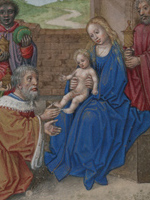
Catholic Church. Horae Beatae Mariae.
Liturgy and ritual. Hours.
Ghent or Bruges, Late 15th Century.
Lessing J. Rosenwald Collection
Rare Book and Special Collections Division
This presentation provides a brief and selected overview of illuminated works in the Library's medieval and renaissance manuscript collections. The examples included in the presentation cover works from the 13th through the 16th centuries.
>> Link to presentation <<
The King James Bible
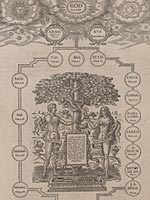
The Holy Bible, conteyning the Old Testament, and the New.
London: Robert Barker, 1611.
Page 2 - Page 3
Special Collection
Rare Book and Special Collections Division (35)
[Digital ID# sjb0035]
King James I commissioned an English translation of the Bible from a committee of fifty-four translators. This massive undertaking produced the "King James," or the "Authorized Version," in 1611. James intended for the Authorized Version to replace the popular Geneva translation, although it took some time for its influence to take hold. The large folio or lectern printing of the King James shown here was issued replete with a variety of informational materials including a note on the translation, a map of the Holy Land, a full calendar of the Church year, and an extensive genealogical chart of the Bible from Adam and Eve to Christ.
Illustrations by Eric Gill
According to the Authorized Version of King James I.
Decorations by Eric Gill.
Waltham Saint Lawrence, Berkshire:
Golden Cockerel Press, 1931.
Press Collection, Rare Book and Special Collections
Division Library of Congress (39)
[Digital ID# sjb0039]
The Library of Congress does not have
permission to show this image online
One of the most important fine press books produced in the 20th century, the 1931 Golden Cockerel press edition of the Four Gospels set the text of the King James gospels into a vision of modern book design. Eric Gill (1882-1940), philosopher, sculptor, and type designer (he developed Perpetua type), designed the text and illustrations to weave and intertwine, producing a modern homage to the tradition of illuminated text.
A Hieroglyphic Bible for Children
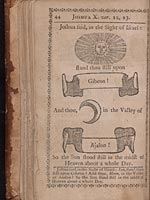
A Curious Hieroglyphick Bible, or,
Select Passages in the Old and
New Testaments, Represented with
Emblematical Figures, for the Amusement of Youth.
Worcester: Isaiah Thomas, 1788. Page 2
American Imprint Collection,
Rare Book and Special Collections Division (40)
[Digital ID# sjb0040]
This "curious" children's Bible, certainly the most ambitious illustrated American book up to its time, contains nearly 500 woodcut images. It was produced by the pioneer publisher of children's books and preeminent early American printer, Isaiah Thomas (1749-1831). A hieroglyphic Bible replaces some of the words of the text with pictures in an attempt to tell a story in a direct and interesting way. Such Bibles were quite popular in the eighteenth century as a device for teaching the Scripture, as well as reading, to youth.
The Geneva Bible
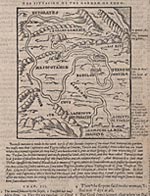
The Bible and Holy Scriptures
Conteyned in the Olde and
Newe Testament.
Geneva: 1560. Page 2
Rare Book and Special Collections Division (41)
[Digital ID# sjb0041]
The Geneva Bible was published in English in Geneva in 1560 by English reformers who fled to the continent to escape persecutions by Queen Mary. The Geneva Bible was used by the Pilgrims and Puritans in New England until it was gradually replaced by the King James Bible. According to one twentieth-century scholar, "between 1560 . . . and 1630 no fewer than about two hundred editions of the Geneva Bible, either as a whole or of the New Testament separately, appeared. It was the Bible of Shakespeare and of John Bunyan and of Cromwell's Army and of the Pilgrim Fathers."
The Eliot Indian Bible: The First Bible Printed in America
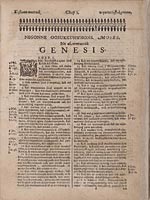
The Holy Bible: Containing the
Old Testament and the New.
Translated into the Indian Language.
Cambridge, Massachusetts: Samuel Green
and Marmaduke Johnson, 1663. Page 2
Bible Collection
Rare Book and Special Collections Division (42)
[Digital ID# sjb0042]
Printed in Cambridge, Massachusetts between 1660 and 1663, the Eliot Indian Bible, as it is now known, was the first complete Bible printed in the western hemisphere. John Eliot, an English Puritan clergyman and pastor of Roxbury, Massachusetts, translated the Bible into the Natick dialect of the region's Algonquin tribes to aid in the propagation of the scriptures. One thousand copies were to be printed by Samuel Green and a young English press assistant, Marmaduke Johnson, an order so large that it required a special shipment of paper from England. Eliot's translation of the text from English into an Algonquin dialect signaled a shift away from historic efforts to consolidate the text of the Bible into familiar languages.
A Classic Printing
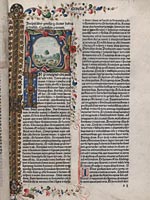
Biblia Sacre.
Venice: Nicolas Jenson, 1479.
Page 2
Lessing J. Rosenwald Collection
Rare Book and Special Collections Division (44)
[Digital ID# sjb0044]
Following its initial printing by Johan Gutenberg in 1454, the Bible was consistently in publication throughout Europe. By 1500 there were well over eighty editions of the Bible printed. Although this 1479 Bible, printed on vellum, was the fourth version to be printed in Venice following the introduction of printing with moveable type, its design and typography destined it to become one of the most revered publications of its kind. Its creator, Nicolas Jenson, was a Frenchman whose Venetian shop printed more than 150 works, primarily ancient classics, legal, and theological literature in the years 1470 to 1480. His Antiqua type, based on Roman inscriptions, is considered the perfect embodiment of humanistic ideals.
The Handwritten Bible
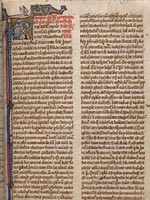
Bible in Latin.
England, First half of the 13th century.
Page 2 - Page 3 - Page 4
Manuscript on vellum. Medieval and Renaissance Manuscript Collection
Rare Book and Special Collections Division (45)
[Digital ID# sjb0045]
The act of creating a manuscript Bible was a complex and time-consuming one. By the 13th century most Bibles were copied by scribes from an exemplar, or master copy, and were produced in greater quantity to meet the demand for the text. Although the larger lectern or folio Bibles lent themselves to elaborate decoration and illumination, smaller, hand-held Bibles, such as this 13th century English copy, were more modest in appearance and more affordable for the clergy and students who acquired them. Several copyists were responsible for transcribing this manuscript Bible, all of them writing in an extremely small cursive form of blackletter known as littera textualis currens, that allowed more than 700 words per page.

